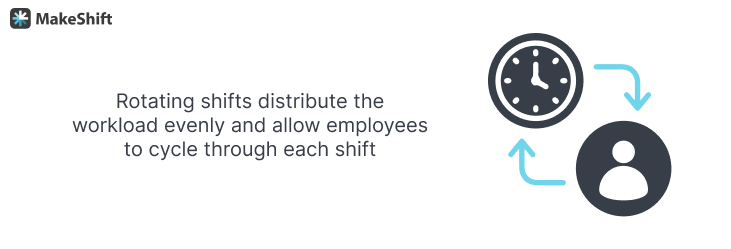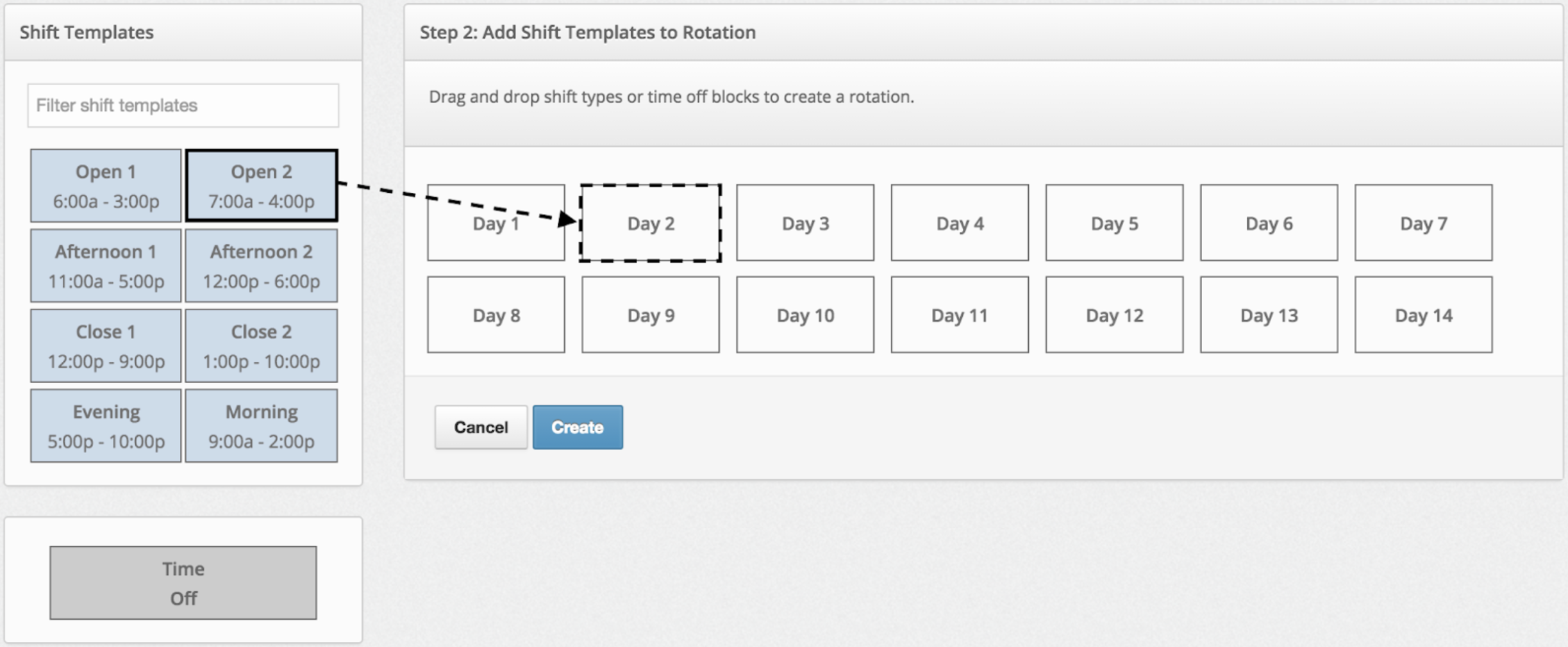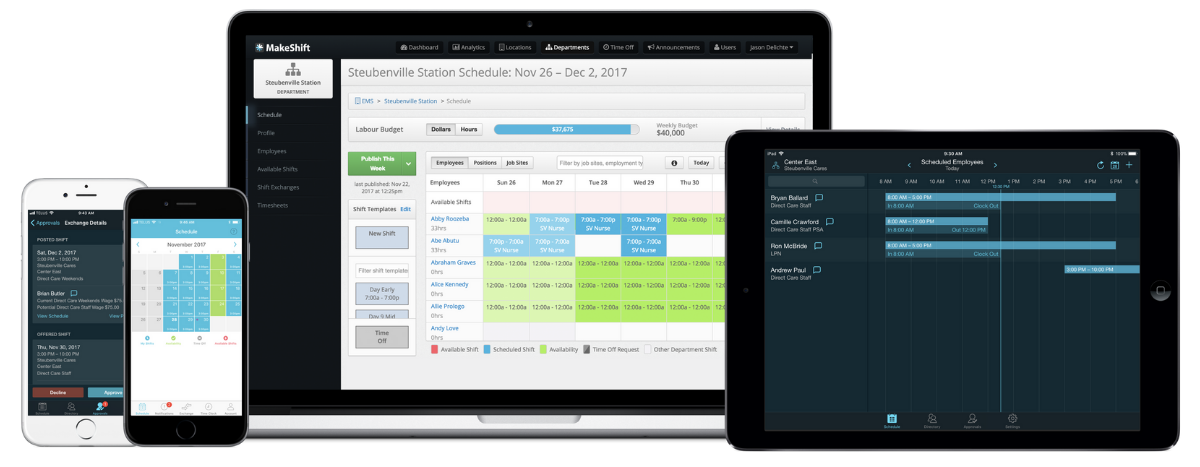People-first businesses prioritize the health and well-being of employees. Why? Because not only is it the right thing to do… there’s also ample evidence that healthier, happier employees drive growth.
If you’re looking to improve employee well-being, consider using rotating shift schedules as they bring more consistency to your employees’ week and let them plan their lives better.
A rotating shifts schedule can also increase productivity, distribute unpopular shifts equally, and improve relationships among employees working with different teams.
So, if you’d like to know if a rotating shifts schedule is worth a try for your employees, keep reading!
In today’s guide, we’ll describe what rotating shifts are, how they can benefit your business, and how to create them.
Let’s get started.
- What Is a Rotating Shift?
- How Does a Rotating Shift Work?
- What Are the Benefits of Rotating Shift Work?
- Weaknesses to Consider with Rotating Shifts
- What Are the Different Types of Rotating Shifts?
- How to Set Up Shift Rotations?
- What Are Rotating Shift Schedule Examples?
- What Is the Best Rotating Shift Schedule?
- Automate the Creation of a Rotating Shifts Schedule
What Is a Rotating Shift?
A rotating shift is when your employees work different shifts on a cycling basis.
For example, let’s say you’re a customer service rep who works at a call center that’s open 24 hours a day. A rotating shift would be if you worked 4 weeks during the day shift followed by 4 weeks of working the night shift.
If you only work during the day shift from 9:00 AM to 5:00 PM Monday through Friday without ever rotating the days or times you work, this is called a fixed schedule. Rotating schedules are the opposite of fixed schedules and have unique benefits that we’ll discuss today.
There are many different types of shift rotation schedules.The best one for your business depends on your industry and needs.
How Does a Rotating Shift Work?
Rotating shifts are commonly used by businesses that are open 24/7 or for extended hours.
Hospitals, restaurants, security details, and retail stores are businesses that often take advantage of a rotational work schedule because of their longer work hours.
| MakeShift Expert Tip: Businesses that are only open from 9:00 AM to 5:00 PM can also benefit from rotating schedules by having employees rotate the days they work, or simply by having morning and afternoon shifts. |
To create a rotating shift schedule, you’ll need to divide your workday into multiple shifts. For example, if your business is open 24 hours a day, you may want to split the workday into the morning, afternoon, and overnight shifts.

Once you decide on the different shifts, you’ll rotate your employees through each shift over the course of a few weeks or months. Rotating shifts are usually 8 to 12 hours long, depending on how you split up the workday.
What Are the Benefits of Rotating Shift Work?
Rotating shifts provide an even distribution of work and a sense of equality among your workforce. While a rotating shift schedule isn’t ideal for all companies, many managers and employees appreciate its benefits which include:
Increased Morale Due to Fair Workload Distribution
Businesses that are open for extended hours will have some employees who consistently work during the busy rush hour shift. These businesses will also have some employees with a backward sleep schedule because they only work during the overnight shift.

Rotating shifts distribute the workload evenly and allow employees to cycle through each shift. This means all of your employees will share in the benefits of specific times, such as a dinner rush in a restaurant where tips are more abundant.
Help Employees Develop Well-Rounded Skillsets
Different times of the day require different tasks, customers, and situations. So if your employees cycle through each shift with a rotating schedule, they’ll have more experience engaging in various tasks.
Also, if team meetings and training sessions typically happen during the day, rotational shift schedules allow each employee to access them on a regular basis.
Provide Scheduling Flexibility for Employees
With rotating work hours, your employees have more flexibility to tend to tasks outside of work. For example, an employee stuck working a fixed schedule with a day shift won’t have as much time to run errands such as going to the dentist or visiting their bank.
Instead, they may need to use their valuable vacation days.
Your employees may appreciate the flexibility of a rotating shift schedule. However, make sure to give them their schedules with plenty of advanced notice to avoid displeased employees (nobody likes finding out they’re working when they have non-work plans).
Weaknesses to Consider with Rotating Shifts
The truth is rotating shifts don’t work for all businesses. There are many weaknesses with rotating shifts that you should know before creating one.
Increased Risk of Animosity Between Employees
There’ll sometimes be more desirable rotations (more day shifts, earlier start times, etc.) for employees. This can potentially cause some friction between employees if they don’t perceive their rotations as fair.
Potentially Damage Work-Life Balance
Working odd shifts around the clock may negatively impact your employee’s work-life balance. For example, if an employee is scheduled to work the overnight shift for a month, they’ll be catching up on sleep during the day and may not have time to meet their family or friends.
Disturb Employees’ Sleep Patterns
The most common drawback of a rotating shifts schedule is disturbing your employees’ sleep patterns and circadian rhythms. Quality sleep is vital for everyone, and the lack of a consistent sleep schedule can decrease employee productivity, happiness, and effectiveness. Also, employees without proper sleep are more prone to stress and errors while working.
What Are the Different Types of Rotating Shifts?
Rotating shifts come in different variations, so it’s important to discuss how they differ. The best rotating shift for your business depends on your business’s needs, processes, and team sizes.
The three factors that differentiate rotating shifts schedules are schedule type, rotation style, and shift length.
Factor 1: Schedule Type
- Traditional rotating schedule: Each crew rotates shifts weekly.
- Slow rotating schedule: Similar to a traditional rotating schedule, but crews switch shifts less often. Many slow rotating schedules call for monthly or annual crew shift rotations.
Factor 2: Rotation Style
- All-shift rotation: Employees take turns working every shift.
- Two-shift rotation: This system involves one fixed shift while the other two shifts rotate.
- Partial rotation: Same as a two-shift rotation but more of the crew is fixed than rotating.
Factor 3: Shift Length
- 8-hour shift: A 24-hour workday is divided into three equal parts.
- 12-hour rotating shift: A 24-hour workday is divided into two 12-hour shifts. This system is common because it's more straightforward, and employees work fewer days total. According to a study by the Finnish Institute of Occupational Health, it found that 12-hour shifts were better for job satisfaction and employee alertness, sleep quality, and work performance.

How to Set Up Shift Rotations?
Creating the perfect rotating shifts schedule involves understanding your employees to their core. You should always prioritize the well-being of your employees.
So before you set up a rotating shift, ask your employees if they would prefer this type of schedule.
The initial step is to break up your company’s workday into different shifts. So if your business is open for 18 hours each day, you can break it up into two 9-hour shifts. Then, determine how many employees need to be present for each shift. Too few employees will cause stress and rushing, while too many employees will cause a lack of productivity.
| MakeShift Expert Tip: Strongly consider having shifts overlap so your employees have the chance to do a knowledge transfer. |
Next, you need to create teams of employees who have complementary skill sets and work well together.
If you don’t know your workforce too well, we recommend creating the teams with a manager who does know and understands each employee.
The last step is to decide how often you want to rotate employees between the different shifts.
We recommend gathering input and feedback from your employees themselves.
What Are Rotating Shift Schedule Examples?
Let’s discuss a few of the most common rotating shift schedules that companies use today.
The DuPont Shift Schedule
The DuPont shift schedule (named after the company that created it) is used by companies open 24 hours a day. This schedule incorporates two 12-hour shifts between four teams of employees.
Each team works a four-week cycle which consists of:
- Four nights or evenings ON
- Three days OFF
- Three days ON
- One day OFF
- Three nights or evenings ON
- Three days OFF
- Four days ON
- Seven days OFF
This adds up to 28 days or four weeks. The DuPont shift schedule is popular because employees get seven consecutive days off at the end of the four-week cycle. This means employees can rest and recharge before returning back to work.
The Pitman Shift Schedule
Similar to DuPont, the Pitman shift schedule uses four teams working two 12-hour shifts. However, the Pitman shift schedule runs on a two-week cycle and requires employees to work two shifts, take two days off, work three shifts, take two days off, work two shifts and take three days off.
Here’s a visualizer (“D” = Day Shift, “O” = Off, “N” = Night Shift):
- Team 1: DDOODDD-OODDOOO
- Team 2: NNOONNN-OONNOOO
- Team 3: OODDOOO-NNOONNN
- Team 4: OONNOOO-DDOODDD
The 24-48 Shift Work Schedule
The 24-48 shift work schedule, also known as the ABC, involves three teams working 24-hour shifts.
Each team works a three-day cycle that looks like this:
- 24 hours ON
- 48 hours OFF
With the 24-48 shift work schedule, employees work a maximum of three days per week and never work an entire weekend. However, strongly consider that working for 24 hours straight can lead to productivity issues and fatigue among your workforce.
The 6-4 6-4 6-4 Shift Work Schedule
The 6-4 6-4 6-4 schedule is a 30-day cycle that uses five teams. The five teams work overlapping 10-hour shifts to provide 24/7 coverage.
Here’s how this rotating shifts schedule looks:
- Six days ON
- Four days OFF
- Six days ON
- Four days OFF
- Six days ON
- Four days OFF
This rotating shift schedule has three teams on duty and two teams off duty on any given day.
The 5-3 5-4 5-3 Shift Work Schedule
The 5-3 5-4 5-3 shift work schedule is similar to the 6-4 6-4 6-4 schedule but consists of a 25-day cycle. Therefore, you’ll need five teams that work three overlapping 10-hour shifts to provide 24/7 coverage.
Here’s how this schedule is structured:
- Five days ON
- Three days OFF
- Five days ON
- Four days OFF
- Five days ON
- Three days OFF
A unique variable is that you can mix shifts from one week to the next. The overlapping shifts provide additional manpower during high activity time periods.
The 4-2 4-3 4-3 Shift Work Schedule
Once again, this shift work schedule uses five teams that work overlapping 10-hour shifts.
However, the 4-2 4-3 4-3 schedule operates on a 20-day cycle that looks like this:
- Four days ON
- Two days OFF
- Four days ON
- Three days OFF
- Four days ON
- Three days OFF
Furthermore, you don’t need to only use 10-hour shifts. Depending on your business's hours, you can adjust your shift lengths.
What Is the Best Rotating Shift Schedule?
The most optimal rotating shift schedule for your business depends on your industry and hours of operation. It also highly depends on your specific workforce since different people have different preferences.
We strongly recommend asking your employees what type of rotating shifts they would prefer working. Since your employees will be putting in the hours, you should adapt to their preferences and keep them happy.
You can provide a list of rotating shifts schedule examples — as we’ve outlined in this article — and see which one they favor.
However, regardless of which rotating shifts schedule you choose, you’ll need to provide clear and consistent communication with your employees. It’s crucial to give your employees plenty of advance notice of shift rosters and schedules.
The best way to accomplish this is by using scheduling software, which automates the entire rotating shifts schedule process.
How to Create a Rotating Shifts Schedule
MakeShift is an all-in-one scheduling solution that optimizes and enhances your team. Our software offers shift scheduling, time and attendance tracking, team communication, and payroll integration.

Our shift templates make creating an effective rotating shifts schedule easy and efficient. MakeShift allows you to create rotations, add shifts to schedules, and create available shifts. Additionally, MakeShift eliminates scheduling errors that may occur from manual scheduling.
You can drag the shift rotation schedule onto the employee's schedule and drop it on the calendar on the day the rotation begins.

After applying the rotation you can determine the length by identifying the date the rotation will end. Then, your employees can easily view which shifts they are scheduled to work on our streamlined interface.
MakeShift is a people-first scheduling software that aims to enhance the quality of life of each of your employees. From upper-level managers to new employees, MakeShift offers effortless convenience and accessibility for creating rotating shift schedules.
Put Your Employees First With Rotating Shift Work
It’s important to accommodate employees who are struggling to adapt to a new rotational shift work schedule. We recommend frequently gathering feedback and asking each employee how they are adjusting to the new employee rotation schedule.
To ensure your rotating shifts schedule is error-free and effective, it’s important to use scheduling software.
Want to see how MakeShift can improve your employees’ morale with rotating shifts? Start your 14-day free trial today








